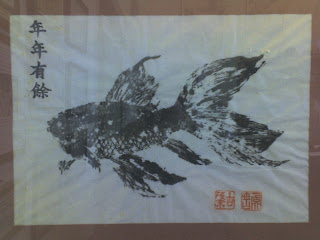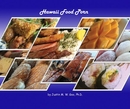Suehiro has always been my favorite since I was a little kid. I remember how that big blue "paper" fan in front would call you in from the street. I remember going upstairs to the the second floor, where instead of tables and chairs, they had tatami mats and tables where you could tuck your legs underneath. I know these are supposed to be more formal Japanese seating, but for a little kid, it's so fun to be free of sitting there in a chair and having something different. It was a restauraunt that I grew up with. When I when to college on the mainland, and came home afterwards bringing some of my mainland friends with me, Suehiro was on the short list of places to take them. I got to show them real old school oyako donburi, and unagi, and miso butterfish, and tempura, and nishime, and sukiyaki. We ordered a virtual feast of all things Japanese that night, and stuffed ourselves silly. But my favorite thing at Suehiro, the thing that stands out most in my memory, is their short rib bento. Their short ribs were sweet, beefy, and fall off the bone tender. I can count on 1 hand the number of places I have ever had short ribs that tender, and I wouldn't even need all my fingers. That was the place to get the most authentic Japanese bentos.
So you can imagine my utter disappointment when they closed up shop and sold the restaurant to Gyotaku, that other Japanese restaurant from Pearl City. In fact, I was so disappointed, that I literally boycotted Gyotaku when they first opened. Who were these usurpers who think they could be as good as my old school favorite?? Who were these people from Pearl City that were invading my turf? I wouldn't stand for it! It wasn't until my parents literally dragged me in to Gyotaku one night, that I finally gave them a chance. And you know what? They just weren't the same. They were a much more... modern and refined style of Japanese, compared to the good old school homestyle cooking that was Suehiro. Everything was prettier, the way the Japanese like to dress up their dishes. Their menu seemed, less familiar, more F.O.B.. It took a really really long time after that, for me to begin to appreciate Gyotaku for what it was. Really good modern Japanese food.
Dragonfly Roll at Gyotaku Restaurant
Gyotaku's sushi menu is actually pretty extensive. No they don't have the old shoyu tuna, with red and green hana ebi rolls like Suehiro used to have. But like Ninja Sushi, they've got a lot of innovative new maki rolls of their own creation. I have 2 favorite rolls there. The first is their Godzilla roll, which is like a super huge shrimp tempura roll, topped with spicy tuna, and avocado. It's a really big mouthful, combining to very distinct but familiar flavors. The other is their Dragonfly roll, which is much more subtle. It's got green onion tempura (that's right, tempura green onion, not shrimp) and avocado, with some spicy salmon and bonito on top. The fact that they've tempura'd something as delicate as green onions, gives this roll a much more sublime green taste, than you normally get out of a bite of sushi.
Pokedon at Gyotaku Restaurant
The thing that Gyotaku really does the best though, is their poke. Here is where the Japanese once again demonstrate their dogged perfectionism. Poke is a Hawaiian dish. Called Hawaii's own soul food, it is the dish that dates back to the oldest Hawaiians. I remember flying to Maui, and reading in the in-flight magazine the history of poke, including some very old sepia toned photographs of little Hawaiian kids biting straight into their fresh catch. This is a dish, that there are hundreds of different recepies for. Just about every family has their own. And I hate to say it, but somehow, the best poke I've ever had is at this Japanese restaurant. How can this be? Well, first consider what bad poke tastes like. When done wrong, the fish is not very fresh and starts to taste fishy (the Chinese have a word for this called "sang"). When done wrong, the fish is not cut properly, and you've got this nasty white gristle that actually gets caught between your teeth. With the Japanese love of sashimi, you've got both the highest quality, freshest fish available, and you've got master chefs that know how to cut the fish so that each bite is smooth and just melts in your mouth. So here the Japanese have taken this beloved Hawaiian dish, perfected it, even adding things you don't normally see like fresh cucumber, and put it on top of a bowl of soft, warm, white rice. It would be infuriating if it wasn't so amazingly delicious. Go at lunch time, and you will get only the best ahi poke around. Go at dinner, and they add all of those other sashimi favorites, like tako, salmon, and hamachi to the mix as well. Add a little shrimp tempura to that, and well....Gyotaku just won me over by brute force.
Pokedon and Tempura Combo at Gyotaku Restaurant
The other thing worth mentioning about going to Gyotaku, is that their walls are completely adorned with their namesake gyotakus. If you don't know, gyotaku is the Japanese art of fish printing. Originally conceived of as a way to document the size of their catch ("I caught a 500lb. marlin.... really!"), gyotaku evolved into a really beautiful art form. They literally take the fish, cover it with ink, and press rice paper upon it to get the printing of the fish. This became really significant to me last year. Remember when we had that huge island wide power outage that lasted over a day? Well, my parents have a koi pond with pretty big koi that they raised from small fries. Unfortunately during the power outage, their pump and filter died, and without it, well... all 15 of their koi died too. The next morning, my mom was just completely heartbroken, staring at all of her dead koi. So, inpired by the restaurant, I came up with the idea of surprising her by trying to make a gyotaku of her largest fishes. After a bit of research on the Internets, a little help from my Uncle, and we gave her a big New Years surprise that literally brought her to tears. They're no where near as beautiful as the gyotaku hanging on the walls at the restaurant, but their sentimental value more makes up for their artistic refinement.
My Own Gyotaku
Life goes on. My mom has replaced her precious koi with a new up and coming school. My favorite old school Japanese restaurant has been replaced by my favorite modern Japanese restaurant. That's just the way life is. You've got to cherish and celebrate the treasured old memories, but at the same time explore and embrace the fresh new experiences. Otherwise, you wind up missing out on one or the other.








Justin,
ReplyDeleteThat's a very touching (and saddening) story about your mom's beloved Koi. Your Gyotaku of her fallen Koi turned out really well. Great job!
What does it say in the Chinese inscription to the left of each one? Is that the name of each Koi?
One thing for sure, judging by the size of the framed Gyotaku art, those Koi were HUGE!
I've heard of some folks who raise Koi here in the island that are worth up $50,000 each in insured value. Unbelievable!
"Hey Rob, how did you afford that brand new Porsche?" "Oh, I sold one of my Koi". lol
I'm wondering if her Koi could have been saved had she had a gas generator to run the pump (life support). She probably didn't expect the Koi and never thought about it. Too late now, but perhaps if she raises more Koi in the future, she should consider having the pump circuit available for plug in to a back-up gas generator.
We had a very good dining experience on our last visit to Gyotaku on King street. I really enjoyed the Nattochos (Natto and Poke on fried wonton chips).
Aloha,
Pomai
The Tasty Island
The inscription on the top fish is "Nin Nin Yao Yuu". In Chinese, Yuu means "fish", but it is also a homonymn for "prosperity". So the top one says "May you have prosperity every year".
ReplyDeleteThe inscription on the bottom fish is taken from a poem. It basically says, "May your blessings run greater than the Eastern Ocean flows."